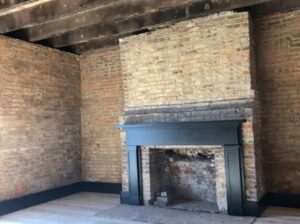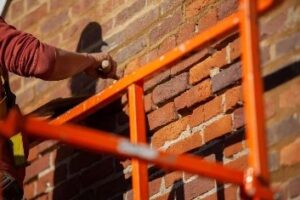(Note: This is part one in a blog series exploring the meaning of several popular phrases and their meaning to historic buildings and homes.)
Everything from the history of a building, whether it is discovering its stories or uncovering its secrets, lies in its architecture.
Many of us love historic architecture. Architecture provides us a peek into the past – surrounding us with reminders of beautiful and, at times, horrible occurrences in history.
Preserving the historic architecture of buildings and homes, however, is a never-ending task. Strict standards, regulated and monitored by the U.S. Department of the Interior Secretary’s Office through the National Park Service, can dictate anything and everything from paint colors, exterior modifications, and best practices for appropriately treating physical issues that may arise. These four distinctive yet interrelated standards – Preservation, Restoration, Rehabilitation, Reconstruction – exist to ensure the highest integrity for historic buildings is maintained. So, what does restoration of a historic building mean?
In layman’s terms, restoration is the process of fully returning a building or a home to its condition at a particular time (period of significance). The National Park Service defines restoration as the “act or process of accurately depicting a property at a particular period of time in its history, while removing all evidence of other periods.” (Learn more about the National Park Service and the U.S. Department of the Interior Secretary’s Standards for Restoration here.) I’ll also note that the four primary standards may be defined differently by various governing bodies including state, county, or local municipalities.
Purchasing a Historic Home
If you have interest in purchasing a historic building or home, it is crucial to know if the building or home is contained within a local historic district, a preservation overlay, or a national historic district before you hire a contractor and begin any construction work. If you do live in a local historic district or neighborhood, there may be additional imposed restrictions – sometimes beyond the Secretary’s Standards – to ensure the building or home keeps within the look and feel of that historic neighborhood or region’s landscape. Stay tuned, as we will cover historic preservation overlays and local historic districts in a future blog!
Depending on the overall goals for the historic building or home, the restoration process usually includes maintaining all or much of the original architectural features and characteristics, and when necessary, reproduce materials and replicate building techniques to ensure a quality restoration. (Side note – it is highly recommended bringing all outdated utilities including water and electric up to code to meet new safety standards as long as it is completed with sensitivity to the historic building or home.)
Awards in Preservation Excellence
For nearly 50 years and counting, the Heritage Foundation of Williamson County, TN recognizes individuals and organizations who pursuit excellence in preservation, restoration, renovation, and rehabilitation as well as infill, craftspeople, and heritage preservation of cultural landscapes. In 2020, we awarded the City of Brentwood our Excellence in Restoration Award for the restoration of the enslaved dwellings at Ravenswood Mansion, now Smith Park. The City of Brentwood’s primary goal was to return the enslaved dwellings to their original appearance.

Restored interior of one of the brick enslaved dwellings at Ravenswood showcases new flooring, appropriate brick restoration of the fireplace and mantel. Image courtesy of Emily West, The Tennessean.
Director of Preservation for the Heritage Foundation Blake Wintory, PhD stated, “In 2019…the city oversaw a careful and expert restoration by Midwest Maintenance of Ohio to clean and repoint brick as well as remove non-original doors and other modern elements. These restored slave dwellings will be an important reminder of the full story in this public space.” To learn more about the 2019 restoration of the enslaved dwellings, please visit The Williamson Home Page’s article.

A skilled brick mason carefully repoints historically appropriate lime putty mortar. Mortar testing occurs prior to restoration to ensure new mortar will match exactly what once existed. Image courtesy of Matt Masters, Williamson Home Page.
Understanding the importance of fully preserving our past means recognizing we are all custodians of our collective history contained within buildings, including homes once lived in by enslaved people. Brentwood Assistant City Manager and Project Lead Jay Evans told the Tennessean, “It is incumbent upon us to ensure those important structures survive the passage of time, and those who lived here, and endured 19th century slavery are not forgotten…this project goes a long way in preserving these historical assets for future generations.”
Community Relations Director Deanna Lambert said, “when you walk into brick structures and look around you know if these walls could talk, they would tell the stories of the harsh reality of those who were enslaved at Ravenswood…The City [of Brentwood] felt it was important to restore these cabins to make sure that future generations learn about the complete history of Middle Tennessee and the sacrifices of many.” Learn more here about the completed restoration in 2020 of the enslaved dwellings at Ravenswood.
Governing Municipalities and Regulations
I briefly mentioned regulations from governing municipalities. Your goals may closely align with regulations set forth by the National Park Service, however; if you purchase a historic building or home in a historic district or neighborhood, there very well might be additional regulatory guidelines in place you must follow. Be sure to know! One of the most critical aspects of restoring a historic building or home is money. It’s necessary to do your homework; find a reputable architect and contractor who are highly skilled in historic building and home restorations and very familiar with your local municipality’s regulations and guidelines.
While many of us love historic buildings and homes, they often come with unforeseen challenges or problems that can cost more money than originally estimated. A historic restoration of a building or home can be quite expensive so remaining realistic about your budget will allow you to make the best decision for purchasing or maintaining the place you love.
To recap, if you are considering a restoration on a historic building or home, what should you do? Before you begin, ask yourself what are your goals? What do you want to accomplish? Depending on its age, former inhabitants or important events that once happened at the historic building or home, its pertinent to do your research prior to beginning restoration. We highly recommend a historic structure report or at the very least, a property history and conditions assessment. Buildings and homes and their stories evolve over time please make sure you know the building or home’s history prior to taking any hammer to the hardwoods. It will help guide you to reach the most appropriate decision.
If you or someone you know is looking for a good roadmap, please contact Senior Director of Preservation and Education Rachael Finch at rfinch@williamsonheritage.org to set up a call or site visit! We help private property owners, real estate agents, and developers learn more about historic properties. Stay tuned for our next blog on one of the more common standards applied to historic buildings and homes when re-evaluating preservation – Rehabilitation!